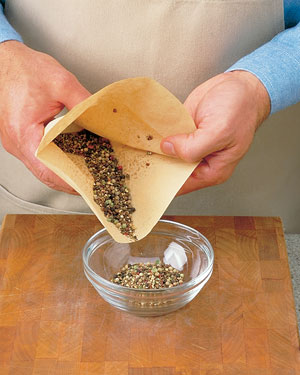Yes, you can grind pepper without a grinder! Several easy methods exist, from using common kitchen tools to simple crushing techniques. This guide explores various ways for crushing peppercorns and creating ground pepper at home. We will discuss alternative pepper grinder solutions, DIY pepper grinding options, spice grinding hacks, and even how to make pepper flakes without a grinder.

Image Source: images.ctfassets.net
Why Grind Your Own Pepper?
Freshly ground pepper offers a far superior flavor compared to pre-ground pepper. Here’s why:
- Flavor Intensity: Whole peppercorns retain their essential oils, which are responsible for pepper’s pungent aroma and taste. Once ground, these oils start to dissipate, leading to a loss of flavor.
- Aroma: The aromatic compounds in pepper are released upon grinding. Freshly ground pepper fills the kitchen with a delightful and invigorating scent.
- Control: Grinding your own pepper allows you to control the grind size. A coarse grind adds texture and a bolder flavor, while a fine grind blends seamlessly into sauces and dressings.
Alternative Pepper Grinder Options: Quick & Easy Methods
Don’t have a pepper grinder? No problem! Here are several alternative pepper grinder methods using tools you likely already have.
The Mighty Mortar and Pestle: A Time-Honored Method
The mortar and pestle is a classic tool for grinding spices, including peppercorns.
-
How To:
- Place a small handful of peppercorns into the mortar.
- Use the pestle to apply firm, downward pressure while twisting and grinding the peppercorns against the mortar’s surface.
- Continue until you reach the desired consistency. For a finer grind, use more pressure and a circular motion. For a coarser grind, use less pressure and a more direct pounding motion.
-
Pros: Excellent control over grind size, releases maximum flavor due to the crushing action.
- Cons: Can be time-consuming, especially for large quantities.
Crushing Peppercorns: The Bag and Rolling Pin Method
This method is a great substitute, requiring minimal equipment.
-
How To:
- Place peppercorns in a sealable plastic bag or between two sheets of parchment paper.
- Use a rolling pin, meat mallet, or even a heavy pan to crush the peppercorns.
- Apply even pressure to avoid tearing the bag or paper.
-
Pros: Quick, easy, and requires minimal cleanup.
- Cons: Less control over grind size; tends to produce a coarser grind.
Using a Knife to Grind Pepper: The Chef’s Shortcut
This method requires caution but can be effective in a pinch.
-
How To:
- Place a small pile of peppercorns on a cutting board.
- Using the flat side of a chef’s knife, gently press down on the peppercorns.
- Rock the knife back and forth, applying pressure to crush the peppercorns.
- Gather the crushed pepper and repeat until desired consistency is achieved.
-
Pros: Relatively quick and easy for small amounts.
- Cons: Requires careful handling to avoid cutting yourself; less control over grind size.
Food Processor Pepper: Grinding in Bulk
For larger quantities, a food processor can be a convenient option.
-
How To:
- Place peppercorns in the food processor.
- Pulse the food processor in short bursts until the peppercorns are ground to your desired consistency. Be careful not to over-process, as this can create pepper dust.
-
Pros: Fast and efficient for grinding large batches.
- Cons: Can be difficult to control grind size; not ideal for small amounts. May require specific food processor blades.
Spice Grinding Hacks: Coffee Grinder to the Rescue
A dedicated coffee grinder (or a spice grinder) can also grind peppercorns. Make sure the grinder is clean and dry before use.
-
How To:
- Place peppercorns in the coffee grinder.
- Grind in short bursts until the desired consistency is reached. Again, avoid over-grinding.
- Thoroughly clean the grinder after use to prevent flavor transfer.
-
Pros: Fast and efficient; produces a consistent grind.
- Cons: Can impart a peppery flavor to future coffee or spice grinding unless thoroughly cleaned.
DIY Pepper Grinding: Creating Pepper Flakes
If you prefer pepper flakes to ground pepper, here’s how to make them without a grinder:
-
How To:
- Use the bag and rolling pin method, but apply less pressure. Aim to crack the peppercorns into smaller pieces rather than grinding them into a fine powder.
- Alternatively, use a mortar and pestle, applying gentle pressure and avoiding a circular grinding motion.
-
Pros: Simple and straightforward; adds texture and visual appeal to dishes.
- Cons: Can be uneven in size; flavor may not be as intense as freshly ground pepper.
Peppercorn Pulverizing Techniques: Fine-Tuning Your Grind
Achieving the perfect grind depends on the method used and the desired outcome. Here are some techniques to fine-tune your pepper grinding:
Achieving a Fine Grind
- Mortar and Pestle: Use firm, consistent pressure with a circular grinding motion.
- Rolling Pin: Apply even pressure and roll the pin back and forth repeatedly.
- Food Processor/Coffee Grinder: Use short pulses to avoid over-grinding.
Achieving a Coarse Grind
- Mortar and Pestle: Use less pressure and a more direct pounding motion.
- Rolling Pin: Apply less pressure and crack the peppercorns gently.
- Knife: Use a rocking motion to crush the peppercorns rather than grinding them.
Tips for Better Grinding
- Dry Peppercorns: Ensure the peppercorns are dry before grinding. Moisture can cause clumping and make grinding more difficult.
- Small Batches: Grind in small batches for better control and consistency.
- Clean Tools: Always clean your grinding tools after use to prevent flavor transfer and maintain hygiene.
Choosing the Right Peppercorns
The type of peppercorn you use will affect the flavor of your ground pepper. Common types include:
- Black Peppercorns: The most common type, offering a bold, pungent flavor.
- White Peppercorns: Milder and more delicate than black peppercorns, with a slightly fermented flavor.
- Green Peppercorns: Fresh, unripe peppercorns with a bright, herbaceous flavor. Often available brined or freeze-dried.
- Pink Peppercorns: Technically not true peppercorns, but berries from the Schinus molle tree. They have a sweet, fruity flavor with a hint of pepperiness.
| Peppercorn Type | Flavor Profile | Best Uses |
|---|---|---|
| Black | Bold, Pungent | All-purpose, steaks, sauces |
| White | Mild, Delicate, Slightly Fermented | White sauces, mashed potatoes, fish |
| Green | Bright, Herbaceous | Asian cuisine, salads, sauces |
| Pink | Sweet, Fruity, Peppery | Desserts, salads, seafood |
Storing Ground Pepper
Proper storage is essential to maintain the flavor and aroma of your freshly ground pepper.
- Airtight Container: Store ground pepper in an airtight container away from light, heat, and moisture.
- Cool, Dark Place: Keep the container in a cool, dark pantry or cupboard.
- Avoid Humidity: Humidity can cause clumping and degrade the flavor of the pepper.
- Use Within 3-6 Months: Ground pepper is best used within 3-6 months for optimal flavor.
Health Benefits of Pepper
Pepper is not only a flavorful spice but also offers several health benefits.
- Antioxidants: Pepper contains antioxidants that help protect against cell damage.
- Anti-inflammatory Properties: Piperine, the active compound in pepper, has anti-inflammatory effects.
- Improved Digestion: Pepper can stimulate digestive enzymes and improve nutrient absorption.
- Pain Relief: Piperine may have pain-relieving properties.
Fathoming the Culinary Uses of Freshly Ground Pepper
Freshly ground pepper enhances a wide range of dishes. Here are some culinary applications:
- Seasoning: Use it to season meats, vegetables, soups, and sauces.
- Marinades: Add it to marinades for extra flavor and tenderness.
- Salad Dressings: Incorporate it into salad dressings for a peppery kick.
- Finishing Touch: Sprinkle it over finished dishes for a burst of aroma and flavor.
- Baking: Use it in savory baked goods like crackers and bread.
FAQ: Common Questions About Grinding Pepper
- What is the best way to grind peppercorns without a grinder? The mortar and pestle provides the best control over grind size and flavor extraction, but the bag and rolling pin method is a quick and easy alternative.
- Can I use a blender to grind pepper? While possible, it’s not recommended. Blenders are designed for liquids and may not grind peppercorns evenly. The resulting pepper may be too fine or powdery.
- How long does freshly ground pepper last? Freshly ground pepper is best used within 3-6 months for optimal flavor.
- What kind of peppercorns should I use? The type of peppercorn depends on your flavor preference. Black peppercorns are the most versatile, while white, green, and pink peppercorns offer unique flavor profiles.
- Why does my pepper taste bland? Pre-ground pepper loses its flavor over time. Always grind your own pepper from whole peppercorns for the best taste.
- Is grinding pepper with a coffee grinder safe? Yes, it’s safe, but thoroughly clean the grinder after use to prevent flavor transfer.
- Can I use a spice grinder for peppercorns? Yes, a dedicated spice grinder works well for grinding peppercorns.
Conclusion
While a pepper grinder is a convenient tool, it’s certainly not essential. These alternative methods offer effective ways to grind peppercorns and enjoy the superior flavor of freshly ground pepper. Experiment with different techniques to find the one that works best for you. Remember to store your ground pepper properly to maintain its flavor and aroma. Enjoy the culinary possibilities of fresh, homemade pepper!

Hi, I’m Larry Fish, the mind behind MyGrinderGuide.com.. With a passion for all things kitchen appliances, I created this blog to share my hands-on experience and expert knowledge. Whether it’s helping you choose the right tools for your culinary adventures or offering tips to make your kitchen more efficient, I’m here to guide you. My goal is to make your time in the kitchen not only easier but also enjoyable! Welcome to my world of kitchen mastery!
